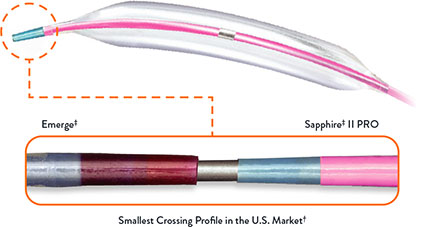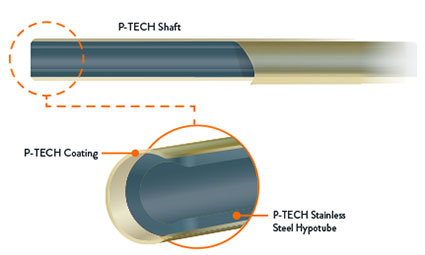Redefining the Standard of Balloon Angioplasty
- 1.0 – 4.0 mm semi-compliant balloon for vascular treatment
- The 1st and only 1.0 mm balloon with FDA clearance†
- Sub-zero tip technology for smooth lesion entry
- P-TECH shaft for optimal pushability and kink resistance
The 1st and Only 1.0 mm Balloon with FDA Clearance
Tip Entry and Crossing Profile Comparison

Sub-Zero Tip Technology for Smooth Lesion Entry
The well-balanced, sub-zero tapered tip has an ultra low profile and provides smooth entry through the tightest lesions.

P-TECH Shaft for Optimal Pushability and Kink Resistance
The P-TECH Shaft is uniquely constructed with a small catheter profile that is kink resistant and facilitates excellent deliverability.

Technical Information
| Sapphire‡ II PRO Balloon Dilatation Catheter | |
|---|---|
| Platform | Over-the-wire (OTW) and Rapid Exchange (RX) |
| Compliance | Semi-compliant |
| Nominal Pressure | 6 atm |
| Rated Burst Pressure | 14 atm |
| Crossing Profile | 0.0216 in (Ø1.0 mm); 0.031 in (Ø3.0 mm) |
| Proximal Shaft | 1.9 F (Ø1.0 - 1.5 mm); 2.0 F (Ø1.75 - 4.0 mm) |
| Distal Shaft | 2.36 F (Ø1.0 - 1.75 mm); 2.55 F (Ø2.0 - 3.0 mm); 2.7 F (Ø3.25 - 4.0 mm) |
| Tip Length | 1.5 mm (Ø1.0 - 1.75 mm); 2.0 mm (Ø2.0 - 3.0 mm); 2.5 mm (Ø3.25 - 4.0 mm) |
| Tip Entry Profile | 0.0164 in (Ø1.0 mm) |
| Balloon Material | Nylon (Ø1.0 - 1.5 mm); Pebax (Ø1.75 - 4.0 mm) |
| Balloon Folds | 2 folds (Ø1.0 mm); 3 folds (Ø1.25 - 4.0 mm) |
| Marker Bands | 1 marker (Ø1.0 - 1.5 mm); 2 markers (Ø1.75 - 4.0 mm) |
| Catheter Length | 150 cm (OTW); 140 cm (RX) |
| Coating | Hydrophilic (distal tip to guidewire exit marker); Hydrophobic (guidewire lumen) |
| Guide Wire Compatibility | 0.014 in |
| Guide Catheter Compatibility | 5 F |
| Not Made With Natural Rubber Latex | Yes |
Ordering Information
| Balloon Diameter (mm) | Balloon Working Length (mm) | |||||||
|---|---|---|---|---|---|---|---|---|
| 5 | 8 | 10 | 12 | 15 | 20 | 30 | ||
| OTW | 1.0 | 501000512 | 501000812 | 501001012 | – | 501001512 | – | – |
| Rx | 1.0 | 210-053-5UU | 210-083-5UU | 210-103-5UU | – | 210-153-5UU | – | – |
| 1.25 | 212-053-5UU | 212-083-5UU | 212-103-5UU | – | 212-153-5UU | – | – | |
| 1.5 | – | – | 215-103-5UU | 215-123-5UU | 215-153-5UU | 215-203-5UU | – | |
| 1.75 | – | – | 217-103-5UU | – | 217-153-5UU | 217-203-5UU | – | |
| 2.0 | – | – | 220-103-5UU | 220-123-5UU | 220-153-5UU | 220-203-5UU | – | |
| 2.25 | – | – | 222-103-5UU | – | 222-153-5UU | 222-203-5UU | – | |
| 2.5 | – | – | 225-103-5UU | 225-123-5UU | 225-153-5UU | 225-203-5UU | 225-303-5UU | |
| 2.75 | – | – | 227-103-5UU | – | 227-153-5UU | 227-203-5UU | – | |
| 3.0 | – | – | 230-103-5UU | 230-123-5UU | 230-153-5UU | 230-203-5UU | 230-303-5UU | |
| 3.25 | – | – | 232-103-5UU | – | 232-153-5UU | 232-203-5UU | – | |
| 3.5 | – | – | 235-103-5UU | – | 235-153-5UU | 235-203-5UU | 235-303-5UU | |
| 4.0 | – | – | 240-103-5UU | – | 240-153-5UU | 240-203-5UU | – | |
Compliance Chart
| Pressure (atm) | Balloon Diameter (mm) | |||||||||||
|---|---|---|---|---|---|---|---|---|---|---|---|---|
| 1.0 | 1.25 | 1.5 | 1.75 | 2.0 | 2.25 | 2.5 | 2.75 | 3.0 | 3.25 | 3.5 | 4.0 | |
| 2 | 0.83 | 1.04 | 1.29 | 1.41 | 1.66 | 1.89 | 2.12 | 2.33 | 2.50 | 2.74 | 2.98 | 3.38 |
| 4 | 0.94 | 1.17 | 1.42 | 1.62 | 1.87 | 2.12 | 2.36 | 2.60 | 2.82 | 3.06 | 3.31 | 3.77 |
| 6 NP* | 1.00 | 1.25 | 1.50 | 1.75 | 2.00 | 2.25 | 2.50 | 2.75 | 3.00 | 3.25 | 3.50 | 4.00 |
| 8 | 1.04 | 1.30 | 1.56 | 1.84 | 2.09 | 2.34 | 2.60 | 2.86 | 3.13 | 3.38 | 3.64 | 4.16 |
| 10 | 1.08 | 1.35 | 1.60 | 1.91 | 2.16 | 2.42 | 2.68 | 2.94 | 3.23 | 3.49 | 3.74 | 4.29 |
| 12 | 1.11 | 1.38 | 1.63 | 1.96 | 2.21 | 2.48 | 2.74 | 3.01 | 3.31 | 3.57 | 3.83 | 4.39 |
| 14 RBP** | 1.13 | 1.41 | 1.66 | 2.01 | 2.26 | 2.53 | 2.79 | 3.07 | 3.38 | 3.64 | 3.90 | 4.48 |
| 16 | 1.15 | 1.41 | 1.69 | 2.05 | 2.30 | 2.57 | 2.84 | 3.12 | 3.44 | 3.70 | 3.96 | 4.55 |
| 18 | 1.17 | 1.46 | 1.71 | 2.09 | 2.34 | 2.61 | 2.88 | 3.17 | 3.50 | 3.76 | 4.02 | 4.62 |
*Nominal Pressure. The nominal in-vitro device specifications do not take into account any lesion resistance.
**Rated Burst Pressure. Do not exceed RBP.
†At time of publication.
Data on file at Abbott.
Sapphire and OrbusNeich are registered trademarks of OrbusNeich Medical Group Holdings Limited or its affiliates. Manufactured by OrbusNeich Medical Group Holdings Limited or its affiliates. Distributed by Cardiovascular Systems, Inc. (CSI). CSI is a subsidiary of the Abbott Group of Companies.
CAUTION: This OrbusNeich product is intended for use by or under the direction of a physician. Prior to use, reference the Instructions for Use at eifu.orbusneich.com for more detailed information on Indications, Contraindications, Warnings, Precautions, and Adverse Events.
MAT-2506879 v1.0
Important Safety Information
Sapphire‡ II Pro Balloon
Dilatation Catheter

INDICATIONS
The Sapphire‡ II PRO Dilatation Catheter (Ø1.0-1.25mm configurations) is indicated for:
- balloon pre-dilatation of a stenotic portion of a coronary artery or bypass graft stenosis (≥70% stenosis) for the purpose of improving myocardial perfusion.
The Sapphire‡ II PRO Dilatation Catheter (Ø1.5-4.0mm configurations) is indicated for:
- balloon dilatation of the stenotic portion of a coronary artery or bypass graft stenosis in patients evidencing coronary ischemia for the purpose of improving myocardial perfusion;
- balloon dilatation of a coronary artery occlusion for the treatment of acute myocardial infarction.
The Sapphire‡ II PRO Dilatation Catheter is also indicated for:
- percutaneous transluminal angioplasty in the peripheral vasculature, including renal, femoral, popliteal, infra-popliteal, tibial, and peroneal arteries.
CONTRAINDICATIONS
The use of the Sapphire‡ II PRO Dilatation Catheter is contraindicated:
- for use in patients with an unprotected left main coronary artery.
- for use in patients with coronary artery spasm in the absence of a significant stenosis.
- for use in the neuro vasculature.
- where there is the inability to cross the target lesion with a guidewire.
WARNINGS
When using this type of device, the following warnings should be observed:
- This device is intended for single use only. Do not resterilize and/or reuse, as this can potentially result in compromised device performance and increased risk of cross-contamination.
- The safety and effectiveness of this balloon catheter for the treatment of in stent restenosis (ISR) has not been established.
- This balloon is not intended for the expansion or delivery of a stent.
- To reduce the potential for vessel damage, the inflated diameter of the balloon should approximate the diameter of the vessel just proximal and distal to the stenosis.
- PTCA in patients who are not acceptable candidates for coronary artery bypass graft surgery require careful consideration, including possible hemodynamic support during PTCA, as treatment of this patient population carries special risk.
- When the catheter is exposed to the vascular system, it should be manipulated while under high-quality fluoroscopic observation. Do not advance or retract the catheter unless the balloon is fully deflated under vacuum. If resistance is met during manipulation, determine the cause of the resistance before proceeding. Applying excessive force to the catheter can result in separation of the tip or balloon.
- Balloon pressure should not exceed the rated burst pressure (RBP) indicated on the package. The rated burst pressure is based on the results of in vitro testing. At least 99.9 percent of the balloons, (with a 95 percent confidence) will not burst at or below their rated burst pressure. Use of a pressure monitoring device is recommended to prevent over pressurization.
- To reduce the potential for air embolus into the vessel, use only the recommended balloon inflation medium. Never use air or any gaseous medium to inflate the balloon.
- For the rapid exchange catheter, do no re-straighten a kinked hypotube; straightening a kinked metal shaft may result in breakage of the shaft.
- PTCA should only be performed at hospitals where emergency coronary artery graft surgery can be quickly performed in the event of a potentially injurious or life-threatening complication.
PRECAUTIONS
- Use the catheter prior to the “Use By” date specified on the package.
- Prior to angioplasty, the catheter should be examined to verify functionality and ensure that its size and shape are suitable for the specific procedure for which it is to be used.
- The catheter system should be used only by physicians trained in percutaneous transluminal coronary or peripheral angioplasty.
- During the procedure, appropriate anticoagulant and vasodilator therapy must be provided to the patient as needed. After the procedure, anticoagulant therapy should be continued for a period of time as determined by the physician.
- Do not reinsert the catheter into the coil dispenser after procedural use.
- Discard all disposable devices used during this procedure per local requirements for medical device waste disposal.
- Do not use oil-based contrast medium, organic solvents or alcohols; there is a possibility of catheter leak, damage, or lubrication loss.
- The balloon deflation time has been established as 15 seconds based on in vitro bench testing results.
- Use with caution for procedures involving calcified lesions due to the abrasive nature of these lesions.
ADVERSE EVENTS
Adverse effects due to the use of this product include, but are not limited to, the following:
- Acute myocardial infarction
- Acute or subacute thrombosis
- Acute vessel closure
- Allergic reaction to device, contrast medium, or medication
- Aneurysm
- Arrhythmias, including ventricular fibrillation
- Arteriovenous fistula
- Coronary artery spasm
- Death
- Dissection (perforation, rupture, or injury) of the vessel
- Hemorrhage or hematoma
- Hypertension
- Hypotension
- Infection
- Restenosis of the dilated vessel
- Stroke, air embolism and embolization of fragmentation of thrombotic or atherosclerotic material
- Total occlusion of the artery or bypass graft
- Unstable angina
CAUTION: This product is intended for use by or under the direction of a physician. Prior to use, reference the Instructions for Use, inside the product carton (when available), at manuals.eifu.abbott or at eifu.orbusneich.com for more detailed information on Indications, Contraindications, Warnings, Precautions and Adverse Events. This material is intended for use with healthcare professionals only.
MAT-2400936 v2.0

Stay Connected